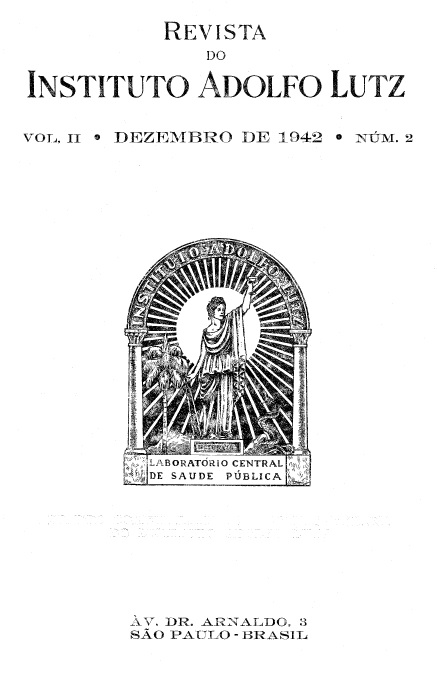Abstract
Out of the catharrhal feces of an eleven months old febrile child, who for the first time had symptoms of dysentery, the author isolated a bacillus which exhibited the following main characteristics of the gen. Eberthella: Rods 1-3µ long, by 0,5-0,6 µ broad, presenting at times long and even filamentous forms. The rods may bé isolated or as diplobacilli with rounded ends, presenting active motility and negative
Gram's stain. Aerobic, facultive.
Pepione broth : Turbidity with scanty deposit. Pronouced butyric odor in 48 hours.
Peptone-agar plates: Superficial, discold colonies, 1 mm. diameter, regular bords, smooth and shining surface, gray and more or less transparent. Deep colonies bi-convexe or oval with smooth borders.
Peptone-açar slants : Abundant growth, grayish, wet, shining and with butyric odor.
Gelatin: No liquefaction.
Rabbit blood agar plates: Luxuriant growth with pronounced butyric odor. No hemolysis.
Potato: In 48-72 hours apreciable growth in wet, yellowish-white layer. Turbility of the sub-jacent fluid.
Acid production, but no gas: Dextrose, saccharose, levulose, glycerol, mannose and adonitol,
No acid or gas: Lactose, D mannitol, maltose, D xylose, dulcitol, celobiose, dextrina, inulina, I inositol, esculina, D sorbitol, L isodulcitol, raffinose, D galactose, L arabinose, salicina, trehalose, amygdalin and amylum.
Litanus milk: Alkaline in 48-72 hours. Strongly alkaline from the 8th. day on.
Indol: Faintly positive 24-48 hours. Positive 96 hours,
Acetyl-methyl-carbinol: Negative.
Methyl red: Positive.
Nitrates: Positive. Reduction to nitrites.
H2S: Positive to paper and agar-lead acetate.
Pathogenesis: Pathogenic for white mice, guinea-pig and rabbits. Given per os, it did not cause disease in M. rhesus or Cebus versuta.
Habitat: Intestinal canal of child suffering from dysentery.
This germ acidifies saccharose slowly (6th. day), and towards the 13th. - 15th. day the medium becomes again alkaline. Both glycerol and adonitol also revert to alkalinity, the first on the 18th. day and the last on the 10th. day. Its action on Litmus milk is very characteristic: sligth alkalinity on the 2nd. or 3rd. day, increasing gradually to the 8th. day, when the tournesol takes a deep blue color. At times there may be a very slight initial acidity in the first 24 hours, a fact the author observed also with the Shigella alkalescens, but this slight change in the tournesol may be practically overlooked. The eberthella thus studied turns alkaline the pepton water, raising its pH as high up as 8.9 (11th. day of inoculation), this being also the maximum reached by the Shigella alkalescens and Faecalis alcaligenes, comparatively studied. Blood serum obtained from the patient on the 10th. day of disease agglutinated the germ in dilutions as high as 1:800. Dead cultures, in suspension, injected in rabbits, produced, in this animal, agglutinins active in titles as high as 1:600. The author looks at this germ as a possible cause of children dysentery and, perhaps, of inflammation of the intestinal tract of adults.The Eb. typhi was not agglutinated by the patient's serum and likewise the germ here studied was not agglutinated by the antiserum Eb. typhi. The germ did not produce soluble toxin in pepton broth kept in incubator at 37o C., for 20 days. According with the work accomplished and based mainly on the data furnished by "Bergey's Manual" (5th. ed'., 1939), the author presumes to be in face of new species of the qen. Eberthella Buchanan, which ought to be placed alongside the Eberthella talavensis. The author finally proposes for this germ the name of Eberthetla alcalifaciens (n. sp.).
References
1. BERGEY'SManual of Determinative Bacteriology - Fifth edition, April 1939. Williams & Wilkins Comp. Baltimore.
2. CASTELANI,A. - Centro f. Bakt. 1. Abt. 65 (262) 1912.
3. ANDREWEs,F. W. - The Lancet, 194 (563) 1918.

This work is licensed under a Creative Commons Attribution 4.0 International License.
Copyright (c) 1944 Instituto Adolfo Lutz Journal
